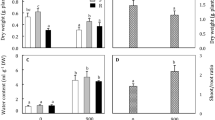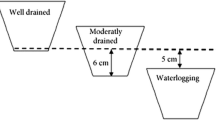Abstract
Growth and physiological characters of Avicennia marina seedlings cultured under different levels of salinity were compared at 45 and 100 days after sowing. Based on the growth and physiological responses, the levels of salinity were grouped into two kinds, moderate (5–30‰) and extreme (40 and 50‰ as well as 0‰). Root and shoot length, leaf area, biomass of different organs, and net photosynthesis rate all showed a similar trend: the seedlings grew better at moderate levels of salinity but were adversely affected by extreme levels. Longer exposure (100 days) to salinity markedly enhanced the difference between the effects of the two levels on growth. By 45th day, the cotyledons had withered and fallen off. The concentration of ions (K+, Na+, Ca2+, Mg2+, Cl−) and ash content of the cotyledons were determined before sowing and 45 days later. Ion concentrations and ash content of cotyledons were markedly lower at 45 days—lower than the initial levels—in seedlings irrigated with water at 0‰ salinity level. This suggested that the poor growth of these seedlings at 100 days may be due to lack of ions provided by the cotyledons. The high ion concentrations in the cotyledons grown at moderate salinity levels suggest that these organs may function as ion sinks at this stage, reducing the concentration of ions and consequent toxicity caused by excessive concentrations. Root biomass was higher than shoot biomass 45 days after sowing, whereas after 100 days, shoot biomass was higher. At the early stage of growth (45 days), the rate of photosynthesis at lower levels of salinity (0–30‰) was limited mainly by stomatal closure but at higher levels of salinity (40–50‰), other factors came into play. Later, at 100 days, the causes of reduced photosynthetic rate were other than stomatal closure at both low and high levels of salinity. This indicates that photosynthesis is affected by prolonged exposure to salt stress—including that caused by 0‰ salinity, as shown by poor growth of the seedlings.





Similar content being viewed by others
References
Ball MC, Farquhar GD (1984a) Photosynthetic and stomatal responses of two mangrove species, Aegiceras corniculatum and Avicennia marina, to long term salinity and humidity conditions. Plant Physiol 74:1–6
Ball MC, Farquhar GD (1984b) Photosynthetic and stomata responses of the grey mangrove, Avicennia marina, to transient salinity conditions. Plant Physiol 74:7–11
Bernstein L (1975) Effect of salinity and sodicity on plant growth. Ann Rev Phytopathol 13:295–312
Clough BF (1984) Growth and salt balance of the mangrove Avicennia marina (Forsk.) Vierh. and Rhizophora stylosa Griff. in relation to salinity. Aust J Plant Physiol 11:419–430
Cramer GR, Läuchli A, Epstein E (1986) Effect of NaCl and CaCl2 on ion activities in complex nutrient solutions and root growth of cotton. Plant Physiol 81:792–797
Downton WJS (1982) Growth and osmotic relations of the mangrove Avicennia marina as influenced by salinity. Aust J Plant Physiol 9:519–528
Farnsworth EJ (2000) The ecology and physiology of viviparous and recalcitrant seeds. Annu Rev Ecol Syst 31:107–138
Farquhar GD, Sharkey TD (1982) Stomatal conductance and photosynthesis. Annu Rev Plant Physiol 33:317–345
Flowers TJ, Troke PF, Yeo AR (1977) The mechanism of salt tolerance in halophytes. Annu Rev Plant Physiol 28:89–121
Greenway H, Munns R (1980) Mechanisms of salt tolerance in non halophytes. Annu Rev Plant Physiol 31:149–190
Guan YX, Dai JY, Lin Y (1995) The photosynthetic stomatal and nonstomatal limitation of plant leaves under water stress (in Chinese). Plant Physiol Commun 31(4):293–297
Jennings DH (1976) The effects of sodium chloride on higher plants. Biol Rev 51:453–486
Lin GH, Sternberg LDaSL (1995) Variation in propagule mass and its effect on carbon assimilation and seedling growth of red mangrove (Rhizophora mangle) in Florida, USA [J]. J Trop Ecol 11:109–119
Lin P (eds) (1997) Mangrove ecosystem in China (in Chinese, with English abstract). Science Press, Beijing
Munns R (1986) Ion activities in solutions in relation to Na+-Ca2+ interactions at the plasma lemma. J Exp Bot 37:320–330
Pezeshki SR, Delanue RD, Patrick WHJ (1990) Differential response of selected mangroves to soil flooding and salinity: gas exchanges and biomass partitioning. Can J For Res 20:869–874
Rabinowitz D (1978) Mortality and initial propagule size in mangrove seedlings in Panama. J Ecol 66:45–51
Tomlinson PB (eds) (1986) The botany of mangroves. Cambridge University Press, Cambridge
Wang WQ, Ke L, Tam NFY, Wong YS (2002) Changes in the main osmotia during the development of Kandelia candel hypocotyls and after mature hypocotyls transplanted in solutions with different salinities. Mar Biol 141:1029–1034
Wang WQ, Lin P (1999) Influence of substrate salinity on the growth of mangrove species of Bruguiera gymnorrhiza seedling (in Chinese). J Xiamen Univ (Nat Sci) 38(2):273–279
Wang WQ, Lin P (2000) Study on membrane lipid peroxidation of the leaves of Kandelia candel seedlings to long-term and short-term salinity (in Chinese). Acta Oceanol Sin 22(3):49–54
Wang WQ, Ye QH, Wang XM, Lin P (2001) Impact of substrate salinity on caloric value, energy accumulation and its distribution in various organs of Bruguiera gymnorrhiza seedlings (in Chinese). Chin J Appl Ecol 12(1):8–12
Wilson C, Lesch SM, Grieve CM (2000) Growth stage modulates salinity tolerance of New Zealand Spinach (Tetragonia tetragonioides Pall.) and red Orach (Atriplex hortensis L.). Annu Bot 85:501–509
Xu DQ (1997) Some problems in stomatal limitation analysis of photosynthesis (in Chinese). Plant Physiol Commun 33(4):241–244
Yeo AR, Flower TJ (1980) Salt tolerance in the halophyte Suaeda maritime L. Dum.: evaluation of the effect of salinity upon growth. J Exp Bot 31:1171–1183
Zhao KF, Wang ST (eds) (1990) Crops resistance physiology. Agriculture Press, Beijing
Zheng WJ, Lin P (1992) Effect of salinity on the growth and some eco-physiological characteristics of mangrove Bruguiera sexangula seedlings. J Appl Ecol 3(1):9–14
Zheng WJ, Wang WQ, Lin P (1999) Dynamic of element contents during the development of hypocotyls and leaves of certain mangrove species. J Exp Mar Biol Ecol 233:247–257
Acknowledgment
The project was jointly supported by Program for Innovative Research Team in Science and Technology in Fujian Province University, Natural Science Fund of China (No. 30200031) and the Program for New Century Excellent Talents in University (NCET). The authors thank Prof. W. J. Cram of University of Newcastle and Dr. Ravi Kumer for their kind help on improving the language of this paper. We also thank the anonymous reviewers for their constructive comments, which improved the manuscript significantly. The authors appreciate Xie Zhong, Lin Xi and Shi Fushan for assistance in seedling cultivation and experimental analysis. All the experiments comply with the current laws of China.
Author information
Authors and Affiliations
Corresponding author
Additional information
Communicated by O. Kinne.
Rights and permissions
About this article
Cite this article
Yan, Z., Wang, W. & Tang, D. Effect of different time of salt stress on growth and some physiological processes of Avicennia marina seedlings. Mar Biol 152, 581–587 (2007). https://doi.org/10.1007/s00227-007-0710-4
Received:
Accepted:
Published:
Issue Date:
DOI: https://doi.org/10.1007/s00227-007-0710-4




